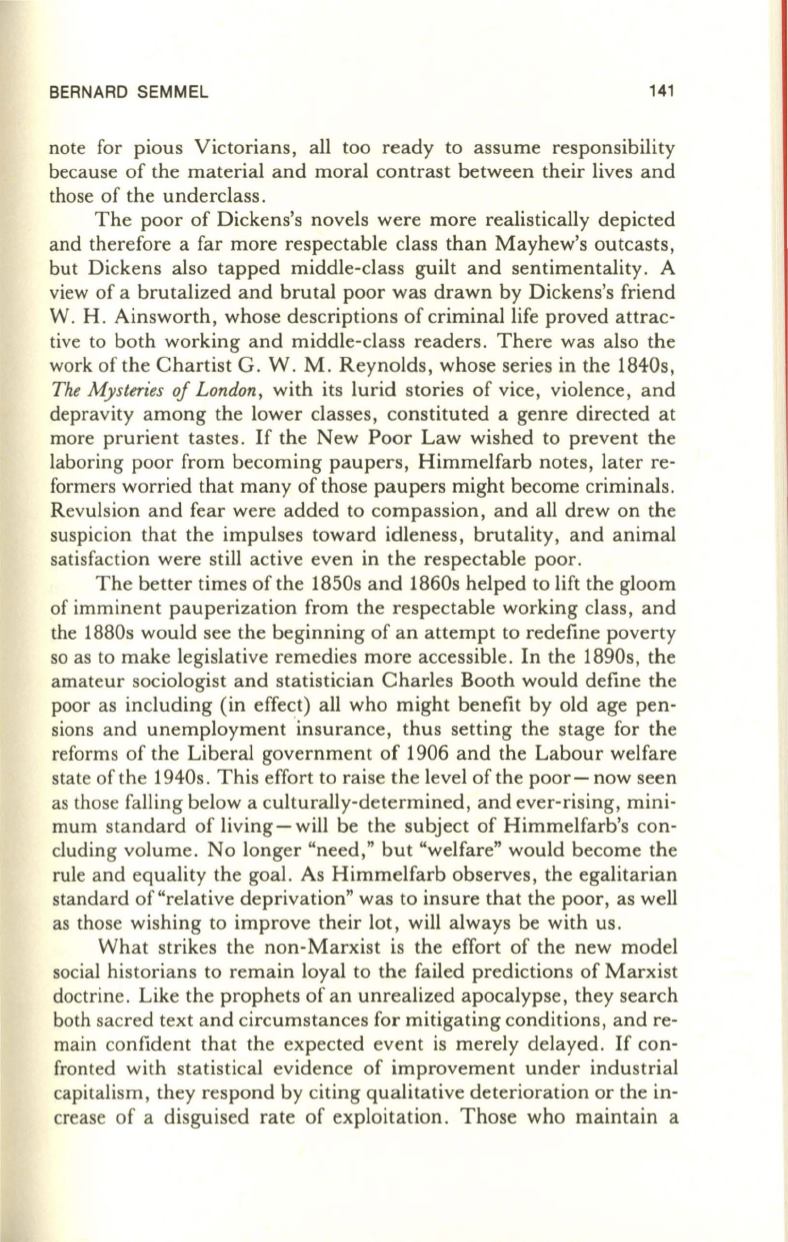
BERNARD SEMMEL
141
note for pious Victorians, all too ready to assume responsibility
because of the material and moral contrast between their lives and
those of the underclass.
The poor of Dickens's novels were more realistically depicted
and therefore a far more respectable class than Mayhew's outcasts,
but Dickens also tapped middle-class guilt and sentimentality . A
view of a brutalized and brutal poor was drawn by Dickens's friend
W. H. Ainsworth, whose descriptions of criminal life proved attrac–
tive to both working and middle-class readers. There was also the
work of the Chartist G. W. M. Reynolds, whose series in the 1840s,
The My steries oj London,
with its lurid stories of vice, violence, and
depravity among the lower classes, constituted a genre directed at
more prurient tastes.
If
the New Poor Law wished to prevent the
laboring poor from becoming paupers, Himmelfarb notes, later re–
formers worried that many of those paupers might become criminals.
Revulsion and fear were added to compassion, and all drew on the
suspicion that the impulses toward idleness, brutality, and animal
satisfaction were still active even in the respectable poor.
The better times of the 1850s and 1860s helped to lift the gloom
of imminent pauperization from the respectable working class , and
the 1880s would see the beginning of an attempt to redefine poverty
so as to make legislative remedies more accessible . In the 1890s, the
amateur sociologist and statistician Charles Booth would define the
poor as including (in effect) all who might benefit by old age pen–
sions and unemployment ·insurance, thus setting the stage for the
reforms of the Liberal government of 1906 and the Labour welfare
state of the 1940s. This effort to raise the level of the poor - now seen
as those falling below a culturally-determined, and ever-rising, mini–
mum standard of living- will be the subject of Himmelfarb's con–
cluding volume. No longer "need," but "welfare" would become the
rule and equality the goal. As Himmelfarb observes, the egalitarian
standard of "relative deprivation" was to insure that the poor, as well
as those wishing to improve their lot, will always be with us .
What strikes the non-Marxist is the effort of the new model
social historians to remain loyal to the failed predictions of Marxist
doctrine. Like the prophets of an unrealized apocalypse , they search
both sacred text and circumstances for mitigating conditions, and re–
main confident that the expected event is merely delayed.
If
con–
fronted with statistical evidence of improvement under industrial
capitalism, they respond by citing qualitative deterioration or the in–
crease of a disguised rate of exploitation . Those who maintain a


